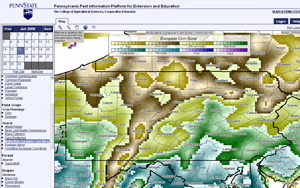Growers PIPE Up for High-Tech Tools
Penn State adapts early warning system for key pests, new crops
 |
|
It’s easy to identify local conditions with PA PIPE. The system, updated daily during the growing season, shows weather to within 6 km2 of a targeted field, plus accumulative ambient degree-days, deviation from normal, 2-inch soil degree-day accumulations, and deviation from normal for 2-inch soil degree-days. |
Pest forecasting models are a powerful IPM tool, but high-tech early-warning systems require significant investment and technical expertise. To save costs, IPM researchers in Pennsylvania have adapted an existing online system that is benefiting growers throughout the state.
The Pennsylvania Pest Information Platform for Extension and Education, or PA PIPE, was developed by Penn State’s College of Agricultural Sciences and an IT firm called ZedX, Inc. The system is based on a tool known as ipmPIPE, created in 2004 as a national decision support system for managing soybean rust.
The PA PIPE provides forecasts for diseases, insects, and weeds, including those that affect field crops, grapes, tree fruit, forests, tomatoes, and potatoes.
“Growers in our state are using the system to predict when pest activity will be happening and to focus their scouting efforts,” explains entomologist John Tooker, who has helped to adapt the system for field crops.
“Timing is critical when it comes to managing plant diseases,” says plant pathologist Beth Gugino, who is fine-tuning models to predict the severity of risk for early blight and late blight. For years, her colleague Alan McNab had issued forecasts to growers throughout the state based on his own network of weather stations. When McNab died in 2006, vegetable growers urged the college to find some way of continuing this crucial service. Their request was the impetus for Penn State’s investment in PA PIPE.
ZedX’s high-resolution weather data drive the specific forecasts of various models within PA PIPE. Once a particular pest model has been plugged into the system, forecasts can be generated on a fairly automatic basis.
Ground-truthing is important though, so Tooker and Gugino verify the system’s predictions and supplement the data with real-world observations. For example, forecasts for the black cutworm depend on the pest’s northward movement during a particular growing season, so Tooker monitors the insect’s arrival across the state. These observations then allow the models to be set in motion and predict larval activity.
Currently there is no cost to growers who use PA PIPE, although additional levels of service might be available for a fee in the future. Growers can log in to the system and save their own data so they can gather crop-, pest-, or location-specific information quickly on their next visits.
“Many states are searching around for different extension models that use information technology,” says PA IPM Coordinator Ed Rajotte, who sees potential for other states to adapt the system and expand its utility. Currently the system covers Pennsylvania and portions of southern New York and northern West Virginia.
For more information about PA PIPE, contact John Tooker, (814) 865-7082, Beth Gugino, (814) 865-7328, or Joe Russo, (814) 357-8490.
— by ELIZABETH MYERS
The Northeastern IPM Center promotes integrated pest management for reducing risks to human health and the environment. If republishing our news, please acknowledge the source (“From Northeast IPM Insights”) along with a link to our website.
